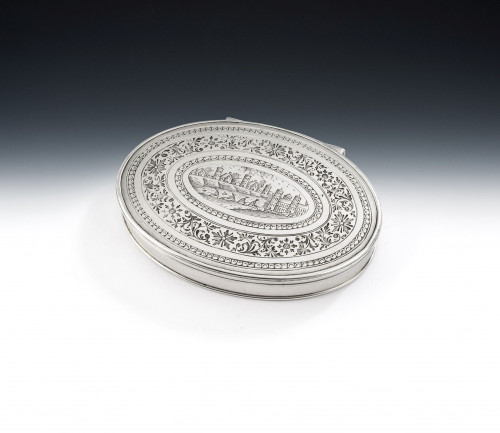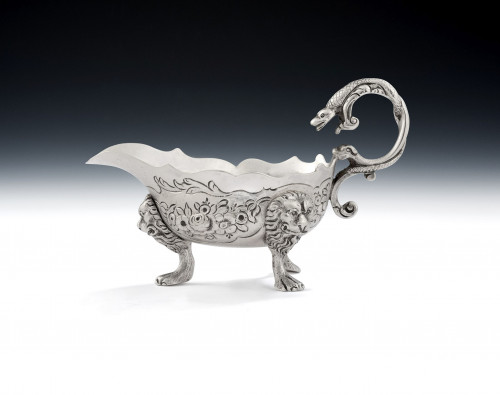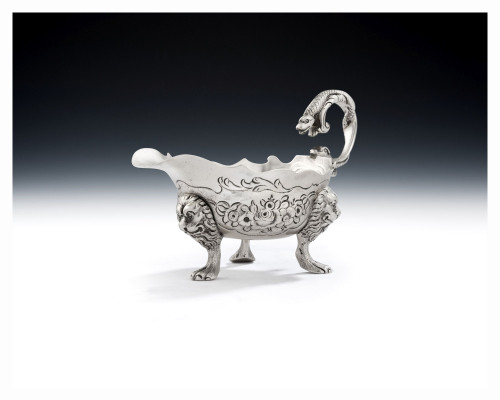Paul Crespin. An important, and unusual, pair of George II Serving Dishes made in London in 1754 by Paul Crespin. From the Collection of the 1st Earl of Hardwicke at Wimpole Hall.
Paul Crespin. An important, and unusual, pair of George II Serving Dishes made in London in 1754 by Paul Crespin. From the Collection of the 1st Earl of Hardwicke at Wimpole Hall.
375437
The Dishes are modelled in a large shaped oval form with raised sides decorated with gadrooning. The centre is engraved with a contemporary Armorial, flanked by supporters, and with the motto “ NEC CUPIAS NEC METUAS” engraved on a banner below. This is all surmounted by the Coronet of an Earl. The reverse is well marked and displays their original engraved scratch weight and their number within the dinner service. The border is also engraved with a second Crest. The Dishes are of the finest quality as would be expected from this highly important maker. Both dishes are in excellent condition, showing limited wear on the front surface.
The Arms, Cornet & Motto are those of Philip Yorke, 1st Earl of Hardwicke, PC (1 December 1690 – 6 March 1764). He was an English lawyer and politician who served as Lord High Chancellor of Great Britain. He was a close confidant of the Duke of Newcastle, Prime Minister between 1754 and 1756 and 1757 until 1762.
A son of Philip Yorke, an attorney, he was born at Dover. Through his mother, Elizabeth, daughter and co-heiress of Richard Gibbon of Rolvenden, Kent, he was connected with the family of Edward Gibbon the historian. He was educated at a school in Bethnal Green run by Samuel Morland, a nonconformist.[1]
At age 16, Yorke entered the attorney's office of Charles Salkeld in Holborn, London. He was entered at the Middle Temple in November 1708, and perhaps recommended by his employer to Lord Chief Justice Parker as law tutor to his sons.
In 1715, Yorke was called to the bar, where his progress was, according to Lord Campbell, more rapid than that of any other debutant in the annals of the profession, his advancement being greatly furthered by the patronage of Thomas Parker, 1st Earl of Macclesfield, who became Lord Chancellor in 1718, when Yorke transferred his practice from the King's Bench to the Court of Chancery, though he continued to go on the Western Circuit. In the following year he established his reputation as an equity lawyer in a case in which Robert Walpole's family was interested, by an argument displaying profound learning and research concerning the jurisdiction of the chancellor, on lines which he afterwards more fully developed in a celebrated letter to Lord Kames on the distinction between law and equity.
Through the Earl of Macclesfield's influence with the Duke of Newcastle Yorke entered parliament in 1719 as member for Lewes, and was appointed solicitor-general, with a knighthood, in 1720, although he was then a barrister of only four years standing.
On 16 May 1719 he married Margaret, daughter of Charles Cocks (by his wife Mary Cocks, sister of Lord Chancellor Somers) and widow of William Lygon (who died without issue in 1716),[2] by whom he had five sons and two daughters:
- Philip Yorke, Viscount Royston (1720–1790), who succeeded him
- Hon. Charles Yorke (1722–1770), became, like his father, Lord Chancellor
- Lady Elizabeth Yorke (1725–1760), married Lord Anson
- Hon. Joseph Yorke (d. 1792), a diplomat, created Baron Dover
- Hon. John Yorke (1728–1801), Member of Parliament for Reigate and Higham Ferrers
- Hon. James Yorke (1730–1808), became Bishop of Ely
- Lady Margaret Yorke, married Sir Gilbert Heathcote, Bt
In 1739, he purchased Wimpole Hall, the greatest country house in Cambridgeshire.
He is buried, with many of his descendants, at the St. Andrew Churchyard at Wimpole. Hardwicke was succeeded in the earldom by his eldest son, Philip. His monument was sculpted by Peter Scheemakers.[3]
Length: 15 inches, 37.5 cm.
Width: 11.25 inches, 28.13 cm
Weight: 73.1 oz, the pair.
PAUL CRESPIN 1694-1770
Born in Westminster to Huguenot parents, Crespin was apprenticed to Jean Pons in 1713. His first marks were entered between 1720 and 1721, when he was described as being free of the Company of Longe Bowe String Makers. From 1720 until about 1760 Crespin conducted business from his address in Compton Street, Soho. He then retired with his wife and daughter to Southampton, where he died at the age of seventy-six. From the outset of his career Crespin distinguished himself as a goldsmith of the greatest ability, attracting patronage from the sovereigns of England, Portugal, and Russia. Although his was apparently a less prolific workshop than Paul de Lamerie's, his most important clients, such as the Prince of Wales and the dukes of Devonshire, Marlborough, and Portland, give some indication of the strength of his reputation. While some of his surviving works, such as the soup tureen of 1740 in the Toledo Museum (Grimwade 1974, pl. 25), testify to his outstanding skills, many of his greatest pieces, such as a "fine silver bathing vessel" made for the king of Portugal in 1724, have been lost.
RELATED ITEMS






























